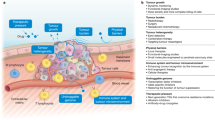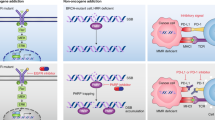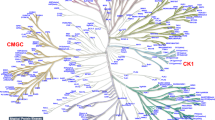Abstract
The term 'undruggable' was coined to describe proteins that could not be targeted pharmacologically. However, progress is being made to 'drug' many of these targets, and therefore more appropriate terms might be 'difficult to drug' or 'yet to be drugged'. Many desirable targets in cancer fall into this category, including the RAS and MYC oncogenes, and pharmacologically targeting these intractable proteins is now a key challenge in cancer research that requires innovation and the development of new technologies. In this Viewpoint article, we asked four scientists working in this field for their opinions on the most crucial advances, as well as the challenges and what the future holds for this important area of research.
This is a preview of subscription content, access via your institution
Access options
Access Nature and 54 other Nature Portfolio journals
Get Nature+, our best-value online-access subscription
$29.99 / 30 days
cancel any time
Subscribe to this journal
Receive 12 print issues and online access
$209.00 per year
only $17.42 per issue
Buy this article
- Purchase on Springer Link
- Instant access to full article PDF
Prices may be subject to local taxes which are calculated during checkout
Similar content being viewed by others
References
Vogelstein, B. et al. Cancer genome landscapes. Science 339, 1546–1558 (2013).
Whitfield, J. R., Beaulieu, M. E. & Soucek, L. Strategies to inhibit myc and their clinical applicability. Front. Cell Dev. Biol. 5, 10 (2017).
McCormick, F. KRAS as a therapeutic target. Clin. Cancer Res. 21, 1797–1801 (2015).
DeVita, V. T. Jr & Rosenberg, S. A. Two hundred years of cancer research. N. Engl. J. Med. 366, 2207–2214 (2012).
Sharma, P. & Allison, J. P. The future of immune checkpoint therapy. Science 348, 56–61 (2015).
Baud, V. & Karin, M. Is NF-κB a good target for cancer therapy? Hopes and pitfalls. Nat. Rev. Drug Discov. 8, 33–40 (2009).
Dang, C. V. MYC on the path to cancer. Cell 149, 22–35 (2012).
Cox, A. D., Fesik, S. W., Kimmelman, A. C., Luo, J. & Der, C. J. Drugging the undruggable RAS: mission possible? Nat. Rev. Drug Discov. 13, 828–851 (2014).
Vigil, D., Cherfils, J., Rossman, K. L. & Der, C. J. Ras superfamily GEFs and GAPs: validated and tractable targets for cancer therapy? Nat. Rev. Cancer 10, 842–857 (2012).
Stephen, A. G., Esposito, D., Bagni, R. K. & McCormick, F. Dragging Ras back in the ring. Cancer Cell 25, 272–281 (2014).
Ostrem, J. M., Peters, U., Sos, M. L., Wells, J. A. & Shokat, K. M. K-Ras (G12C) inhibitors allosterically control GTP affinity and effector interactions. Nature 503, 548–551 (2013).
Patricelli, M. P. et al. Selective inhibition of oncogenic KRAS output with small molecules targeting the inactive state. Cancer Discov. 6, 316–329 (2016).
Lito, P., Solomon, M., Li, L.-S., Hansen, R. & Rosen, N. Allele-specific inhibitors inactivate mutant KRAS G12C by a trapping mechanism. Science 351, 604–608 (2016).
Otto, T. et al. Stabilization of N-Myc is a critical function of Aurora A in human neuroblastoma. Cancer Cell 15, 67–78 (2009).
Gustafson, W. C. et al. Drugging MYCN through an allosteric transition in Aurora kinase A. Cancer Cell 26, 414–427 (2014).
Richards, M. W. et al. Structural basis of N-Myc binding by Aurora-A and its destabilization by kinase inhibitors. Proc. Natl Acad. Sci. USA 113, 13726–13731 (2016).
Watson, P. A., Arora, V. K. & Sawyers, C. L. Emerging mechanisms of resistance to androgen receptor inhibitors in prostate cancer. Nat. Rev. Cancer 15, 701–711 (2015).
Antonarakis, E. S. et al. AR-V7 and resistance to enzalutamide and abiraterone in prostate cancer. N. Engl. J. Med. 371, 1028–1038 (2014).
Lazo, J. S. & Sharlow, E. R. Drugging undruggable molecular cancer targets. Annu. Rev. Pharmacol. Toxicol. 56, 23–40 (2016).
Verdine, G. L. & Walensky, L. D. The challenge of drugging undruggable targets in cancer: lessons learned from targeting BCL-2 family members. Clin. Cancer Res. 13, 7264–7270 (2007).
Makley, L. N. & Gestwicki, J. E. Expanding the number of 'druggable' targets: non-enzymes and protein-protein interactions. Chem. Biol. Drug Des. 81, 22–32 (2013).
Hsieh, A. L. & Dang, C. V. MYC, metabolic synthetic lethality, and cancer. Recent Results Cancer Res. 207, 73–91 (2016).
Soucek, L. et al. Inhibition of Myc family proteins eradicates KRas-driven lung cancer in mice. Genes Dev. 27, 504–513 (2013).
Massarelli, E. et al. KRAS mutation is an important predictor of resistance to therapy with epidermal growth factor receptor tyrosine kinase inhibitors in non-small-cell lung cancer. Clin. Cancer Res. 13, 2890–2896 (2007).
Weinstein, I. B. & Joe, A. K. Mechanisms of disease: oncogene addiction—a rationale for molecular targeting in cancer therapy. Nat. Clin. Pract. Oncol. 3, 448–457 (2006).
Evan, G. Taking a back door to target Myc. Science 335, 293–294 (2012).
Commisso, C. et al. Macropinocytosis of protein is an amino acid supply route in Ras-transformed cells. Nature 497, 633–637 (2013).
Mertz, J. A. et al. Targeting MYC dependence in cancer by inhibiting BET bromodomains. Proc. Natl Acad. Sci. USA 108, 16669–16674 (2011).
Farrell, A. S. & Sears, R. C. MYC degradation. Cold Spring Harb. Perspect. Med. 4, a014365 (2014).
Fletcher, S. & Prochownik, E. V. Small-molecule inhibitors of the Myc oncoprotein. Biochim. Biophys. Acta 1849, 525–543 (2015).
Neklesa, T. K., Winkler, J. D. & Crews, C. M. Targeted protein degradation by PROTACs. Pharmacol. Ther. (2017).
Heller, G. T., Sormanni, P. & Vendruscolo, M. Targeting disordered proteins with small molecules using entropy. Trends Biochem. Sci. 40, 491–496 (2015).
Hammoudeh, D. I., Follis, A. V., Prochownik, E. V. & Metallo, S. J. Multiple independent binding sites for small-molecule inhibitors on the oncoprotein c-Myc. J. Am. Chem. Soc. 131, 7390–7401 (2009).
Barber-Rotenberg, J. S. et al. Single enantiomer of YK-4-279 demonstrates specificity in targeting the oncogene EWS–FLI1. Oncotarget 3, 172–182 (2012).
Welsch, M. E. et al. Multivalent small-molecule pan-RAS inhibitors. Cell 168, 878–889 (2017).
Shimizu, T. et al. The clinical effect of the dual-targeting strategy involving PI3K/AKT/mTOR and RAS/MEK/ERK pathways in patients with advanced cancer. Clin. Cancer Res. 18, 2316–2325 (2012).
Athuluri-Divakar, S. K. et al. A small molecule RAS-mimetic disrupts RAS association with effector proteins to block signaling. Cell 165, 643–655 (2016).
Filippakopoulos, P. et al. Selective inhibition of BET bromodomains. Nature 468, 1067–1073 (2010).
Lai, A. C. & Crews, C. M. Induced protein degradation: an emerging drug discovery paradigm. Nat. Rev. Drug Discov. 16, 101–114 (2017).
Frye, S. V. The art of the chemical probe. Nat. Chem. Biol. 6, 159–161 (2010).
Deng, J. How to unleash mitochondrial apoptotic blockades to kill cancers? Acta Pharm. Sin. B 7, 18–26 (2017).
Kotschy, A. et al. The MCL1 inhibitor S63845 is tolerable and effective in diverse cancer models. Nature 538, 477–482 (2016).
Young, S. W., Stenzel, M. & Yang, J. L. Nanoparticle-siRNA: a potential cancer therapy? Crit. Rev. Oncol. Hematol. 98, 159–169 (2016).
Zhang, C. et al. Antisense oligonucleotides: target validation and development of systemically delivered therapeutic nanoparticles. Methods Mol. Biol. 361, 163–185 (2007).
Shen, M., Schmitt, S., Buac, D. & Dou, Q. P. Targeting the ubiquitin–proteasome system for cancer therapy. Expert Opin. Ther. Targets 17, 1091–1108 (2013).
Fosgerau, K. & Hoffmann, T. Peptide therapeutics: current status and future directions. Drug Discov. Today 20, 122–128 (2015).
Kapoor, A. et al. Yap1 activation enables bypass of oncogenic Kras addiction in pancreatic cancer. Cell 158, 185–697 (2014).
Viale, A. et al. Oncogene ablation-resistant pancreatic cancer cells depend on mitochondrial function. Nature 514, 628–632 (2014).
Engelke, C. G. & Chinnaiyan, A. aBETting therapeutic resistance by Wnt signaling. Cell Res. 25, 1187–1188 (2015).
Belchis, D. A. et al. Heterogeneity of resistance mutations detectable by next generation sequencing in TKI-treated lung adenocarcinoma. Oncotarget 7, 45237–45248 (2016).
Martin, S. D., Coukos, G., Holt, R. A. & Nelson, B. H. Targeting the undruggable: immunotherapy meets personalized oncology in the genomic era. Ann. Oncol. 26, 2367–2374 (2015).
Matyskiela, M. E. et al. A novel cereblon modulator recruits GSPT1 to the CRL4CRBN ubiquitin ligase. Nature 535, 252–257 (2016).
Ottis, P. & Crews, C. M. Proteolysis-targeting chimeras: induced protein degradation as a therapeutic strategy. ACS Chem. Biol. 12, 892–898 (2017).
Serafimova, I. M. et al. Reversible targeting of noncatalytic cysteines with chemically tuned electrophiles. Nat. Chem. Biol. 8, 471–476 (2012).
Oksenberg, D. et al. GBT440 increases haemoglobin oxygen affinity, reduces sickling and prolongs RBC half-life in a murine model of sickle cell disease. Br. J. Haematol. 175, 151–153 (2016).
Soucek, L. et al. Modelling Myc inhibition as a cancer therapy. Nature 455, 679–683 (2008).
Acknowledgements
K.M.S. would like to thank J. Taunton for pointing out the example of GBT440. L.S. acknowledges funding from the European Research Council (CoG Grant #617473), the Instituto de Salud Carlos III (FIS Grant #PI13/01705 and #PI16/01224), the BBVA Foundation and the FERO Foundation.
Author information
Authors and Affiliations
Corresponding authors
Ethics declarations
Competing interests
C.V.D. declares no competing interests. E.P.R. is the scientific founder, Board member and paid consultant of Onconova Therapeutics, Inc., which is developing rigosertib for cancer therapy. K.M.S. is an inventor on patents related to KRAS-G12C-targeting drugs licensed to Araxes Pharma. He is also a shareholder and consultant to Araxes Pharma. L.S. is founder and shareholder of Peptomyc S.L.
Related links
Rights and permissions
About this article
Cite this article
Dang, C., Reddy, E., Shokat, K. et al. Drugging the 'undruggable' cancer targets. Nat Rev Cancer 17, 502–508 (2017). https://doi.org/10.1038/nrc.2017.36
Published:
Issue Date:
DOI: https://doi.org/10.1038/nrc.2017.36
This article is cited by
-
Nucleic acid therapeutics as differentiation agents for myeloid leukemias
Leukemia (2024)
-
Protein-templated ligand discovery via the selection of DNA-encoded dynamic libraries
Nature Chemistry (2024)
-
Inhibition of high level E2F in a RB1 proficient MYCN overexpressing chicken retinoblastoma model normalizes neoplastic behaviour
Cellular Oncology (2024)
-
MYC targeting by OMO-103 in solid tumors: a phase 1 trial
Nature Medicine (2024)
-
PROTAC’ing oncoproteins: targeted protein degradation for cancer therapy
Molecular Cancer (2023)



